DELICIOUS Jjajangmyeon Recipe-Korean Black Bean Noodles.

Rich.
Decadent.
Comfort food to the max.
This Korean black bean noodles or jjajangmyeon recipe is the stuff of legends (thanks to movies like the Oscar award winning Parasite!). It is my father’s all-time favorite dish and therefore, one I grew up eating a lot. Believe it or not, my father loves my jjajangmyeon recipe (he told me to open a restaurant after trying it!). It is a noodle dish smothered in a glossy gravy made of stir-fried fermented black soybean paste and tons of vegetables.
Now, because it is a fried dish, the traditional version does contain a significant amount of oil. This is why all the k-pop idols classify these noodles as their “cheat meal”! It’s definitely one you make for special occasions. However, keep your eyes peeled for my OIL FREE modifications. I truly want to make this classic Korean-Chinese recipe as inclusive as possible!
So, let’s get into it!
Disclaimer: Some of the links in this post may be affiliate links for products I use and love. If you make a purchase after clicking one of those links, I may earn a small affiliate commission, perhaps enough to buy some extra gochujang or gochugaru 🙂
What Even Is Jjajangmyeon?

Jjajangmyeon (짜장면) is a joinder of two words: jjajang, which refers to a gravy made out of fermented soybean paste, and myeon, which, you may notice, sounds a lot like the second syllable of the Korean word for ramen or ramyeon, means noodles. Hence, put together, jjajangmyeon means fermented black bean noodles or Korean black bean noodles. When I was growing up, I sometimes called it “black spaghetti” (how’s that for third culture childhood!).
In Korean, the black fermented soybean paste is called “chunjang” (춘장). Made out of blocks of fermented soybeans (yellow or black soybeans), the black bean paste is quite pungent and even bitter unless it is stir-fried. The stir-fried paste is then mixed together with chunks of steak, pork, or seafood, together with a chunky vegetables, and stewed until it turns into a thick gravy or black bean sauce. It is then mixed together with wheat noodles (though, of course, feel free to use whatever gluten-free noodles you enjoy best) and served with pickled daikon, kimchi, and raw onions.
As you may have noticed, jjajangmyeon isn’t like a lot of Korean dishes. For one, it’s not meant to be eaten with a lot of banchan (only the three identified above). Secondly, Korean noodles are usually skinnier (like somyeon in Bibim Kimchi Guksu) or served in a broth (like Kong Guksu). This is because jjajangmyeon is considered by most Korean people (including my father) to be a Chinese dish. Technically, the dish “originated” inside the borders of Korea, but it was a reimagination or “take” on Chinese noodles that was quite popular with the Chinese migrants who found themselves in Incheon.
I like to think of jjajangmyeon as a Chinese-Korean dish–a nod to the fact that Korean people view these noodles as a Chinese specialty, while acknowledging that it is still a Korean creation. More importantly, it imparts some very practical and useful information: you cannot order jjajangmyeon at a Korean restaurant or at a Chinese restaurant. Rather, jjajangmyeon is only available in a Korean-Chinese restaurant, which, if you’re neither Korean nor Chinese, might be hard to identify.
The best advice I can give you is (a) you’ll know you’re at one of these unique eateries if the host or hostess can speak both Chinese and Korean, and (b) just ask your Korean American friends where their fave “jjajangmyeon spot” is.
Finally, if you’re vegan or vegetarian, or have a shellfish allergy, word to the wise: it is very hard to find jjajangmyeon that is made without animal products. Even if the restaurant offers “gan jjajangmyeon” or “plain jjajangmyeon” which won’t contain hunks of meat or seafood, the gravy can still contain oyster sauce, fish sauce, or beef broth.
I thus bring to you this fully animal-product-free vegan jjajangmyeon recipe!
Key Ingredients and Notes on Substitutions for Jjajangmyeon Recipe.
Chunjang or Roasted Jjajang Paste.

There are two ingredients in this jjajangmyeon recipe that you can only find in a Chinese or Korean grocery store. One of those is chunjang or jjajang paste (the other is the noodle). As you can see, it usually comes in a small jar. As we discussed above, chunjang is made out of fermented soybeans that are treated to have a glossy, black color, like molasses. The paste is pungent, salty, nutty, a little sweet, and a little bitter. These days, you can find pre-roasted chunjang paste, as pictured above. This takes a lot of the bitterness out of the chunjang, so that the paste is ready to “saucify.”
Unfortunately for my gluten-intolerant friends, traditional chunjang is made with wheat and try as I might, I have never found a gluten-free version at the Korean grocery store. However, many Chinese black bean sauces (which are not the same but similar to chunjang), like this one, do not contain gluten.
Frozen Green Peas.
I don’t usually see peas in the jjajangmyeon I get at restaurants, but it’s often in the instant jjajangmyeon or “chapaghetti” my father used to make for us growing up. I thus throw in a handful of frozen peas into the gravy for this jjajangmyeon recipe, for a little extra color and protein. If you want to use fresh green peas, make sure to add them with the other vegetables, so they cook along with the potatoes (and not at the end which is what I do with the frozen ones).
Vegetables.
In order to make the gravy nice and chunky, this jjajangmyeon recipe will stick to many of the veggies you’d see at restaurant:
- Onion
- Garlic
- Potato
- Zucchini (ok, technically this is a fruit)
- Cabbage
Of these, I would say the most important is onion. You really cannot make jjajangmyeon without onion. The other ingredients are pretty traditional but not absolutely mandatory. If you don’t have potato, double up on the zucchini and vice versa. Add some carrots. I wouldn’t add sweet potato as the gravy will then take forever to cook, but yukons, yellow, white, or even russets are a great spud for this jjajangmyeon recipe.
Oil.
As I mentioned, traditional chunjang is stir-fried in order to mellow out the bitterness of the fermented soybeans. Therefore, this jjajangmyeon recipe will contain vegetable oil. However, these days, many commercial chunjang or jjajang pastes have much of the bitterness already leached out. Accordingly, you can substitute vegetable broth for oil in this jjajangmyeon recipe. The gravy won’t be as rich or glossy, but it will still be flavorful and hearty.
Vegetable Broth.
One of the tricks I use for my jjajangmyeon recipe is vegetable broth. I genuinely think this is why my father enjoys my recipe so much! It gives the gravy body and dimension which plain old water isn’t going to have. I use store-bought veggie stock when I don’t have time to make my own and it tastes GREAT.
Soup Soy Sauce.
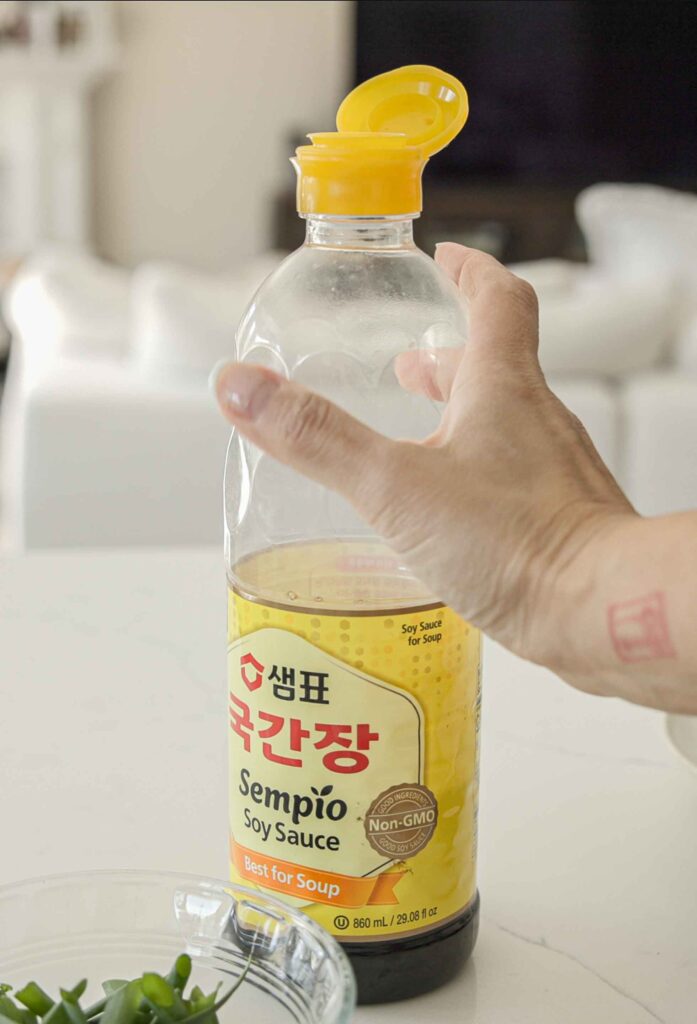
Another flavor agent I love to use for my jjajangmyeon recipe is soup soy sauce. What is soup soy sauce? If you have my book, you already know! If you don’t have my book, why not…? In any event, soup soy sauce is a particular kind of Korean soy sauce made for, you guessed it: soup! It’s a cleaner, saltier, and lighter colored soy sauce than regular soy sauce. I use a little bit in this jjajangmyeon recipe to give it extra umami.
If you don’t have soup soy sauce, go ahead and use whatever soy sauce you prefer, including tamari (which is gluten-free) or low sodium soy sauce. Of course, you can always use soy-free sauce or coconut aminos, as well.
Sweetener.
Jjajangmyeon is salty but also a little sweet. I think bad jjajangmyeon is overly salty without having a sweetness to balance it out. For this jjajangmyeon recipe, I use brown rice syrup. The deep, earthy sweetness of this syrup pairs so well with the dark gravy. However, you can really use whatever sweetener you want: maple syrup, agave, brown sugar, white sugar, etc. (though you may have to adjust the amounts to account for the disparity in sweetness).
Potato Starch.
In order to thicken the sauce into a proper gravy for this jjajangmyeon recipe, we use potato starch and water to create a roux. Why potato starch? I’ve found that many Korean restaurants use potato starch over corn starch. Moreover, potato starch will do a better job of creating the trademark glossiness for the jjajangmyeon sauce. However, if you don’t have potato starch, you can use corn starch.
Vegan “Steak.”

I made this jjajangmyeon recipe using Impossible’s Steak Bites (they sent me a bag so I thought I’d give it a try!). I have to say, this was the closest thing I’ve had to the jjajangmyeon I used to eat with my dad at the Korean Chinese restaurants when I was little. It was pretty mind-blowing! But if you don’t have access to Impossible Meat’s Steak Bites, use whatever chunky vegan meat you enjoy or shiitake mushrooms or super firm tofu.
If you are keeping this recipe OIL FREE, I would use sliced shiitake mushrooms and throw them in with the onions and garlic.
Chinese Wheat Noodles.
Of all the ingredients for this jjajangmyeon recipe, I find this one to be most difficult. Not because purported “jjajangmyeon noodles” are hard to find (they’re all over the Korean grocery store) but because none of them look, taste, or feel like the noodles I’ve had at a Chinese-Korean restaurant. The vast majority of the noodles you’ll find at a Korean grocery store are either kahlguksu (knife cut noodles) or udon. Neither of these have the texture of the thick, chewy wheat noodles I remember from my childhood.
That said, if you’re not picky, like me, go with whatever variety of noodles you like. Heck, I’ve made this jjajangmyeon recipe with gluten-free spaghetti noodles and it always tastes GREAT!
Step-by-Step Instructions for Making Jjajangmyeon Recipe.
Step 1.
(Skip if making this OIL FREE) Add oil to a large wok over medium-high heat. When the oil begins to shimmer (around 1 minute), add the vegan steak. Cook until browned (around 2 to 3 minutes). Remove from wok and drain excess oil on paper towel. Set aside.

Step 2.
(Add vegetable broth if making this OIL FREE) To the same pan in which you cooked the vegan steak, add onions and garlic (and mushrooms, if substituting for vegan steak). Sauté until the onions and mushrooms begin to brown (around 3 minutes). Create a well in the center of your wok and add 1 tablespoon of oil (or vegetable broth). When the oil begins to shimmer (around 30 seconds), add chunjang. Gently sauté the paste in the oil until it becomes extra glossy.
Step 3.
Next, add the zucchini, potato, and cabbage and continue sautéing until zucchini begins to get soft (around 2 minutes). Season with salt and pepper. Incorporate the stir-fried vegetables into the paste until evenly coated. Deglaze the pan with soy sauce and add sweetener. Stir the contents of the pan until the vegetables are glossy.
Step 4.
Add vegetable broth and bring to a boil. Then lower heat to low and let the contents simmer until the potatoes are fork tender (about 15 minutes). While the sauce is stewing, create a roux by whisking together the potato starch with 1/4 cup of water. When the potatoes are just about cooked, add frozen peas, the vegan steak that was removed at the beginning, and the roux. Continue stirring over low heat until the sauce thickens into a gravy consistency. Pour over cooked noodles and enjoy with pickled daikon, kimchi, and raw onions.


Frequently Asked Questions.
Can you make jjajangmyeon gluten-free?
Korean chunjang, the paste from which jjajangmyeon sauce is made, is not gluten-free. However, if you use Chinese black bean sauce (which tastes similar and often does not contain gluten), along with gluten-free noodles, you can make a black bean noodles recipe that is very similar to a jjajangmyeon recipe.
What is the sauce for jjajangmyeon made out of?
The sauce for jjajangmyeon or Korean-Chinese black bean noodles is made out of chunjang paste (a dark fermented soybean paste), together with meat or seafood, as well as vegetables. The sauce is usually thickened into a gravy and served over a bowl of wheat noodles.
Is jjajangmyeon the same dish that was in Parasite?
Yes! Sort of… the jjajangmyeon featured in the Oscar award winning Parasite was actually instant jjajangmyeon famously made with filet mignon. The juxtaposition of cheap noodles with expensive meat was a metaphor for the elision of poverty and obscene wealth in Korean society. This jjajangmyeon recipe is not of the instant variety, and, lucky for you, doesn’t entail chunks of expensive meat, either!
Do I need to use vegan steak for this jjajangmyeon recipe?
Nope! You can substitute with tofu or shiitake mushrooms!
Want More Noodle Recipes?
I got you. Check out the following:
Recipe Card.

Vegan Jjajangmyeon – Korean-Chinese Black Bean Noodles.
Ingredients
- 2 tbsp vegetable oil
- 3/4 cup vegan steak
- 1/2 cup onion (chopped)
- 3 cloves garlic (minced)
- 1/3 cup jjajang paste
- 1/2 cup zucchini (chopped)
- 1 yellow potato (diced)
- 1/2 tsp sea salt
- 1 cup cabbage (chopped)
- 1/2 tsp black pepper
- 1 tbsp soup soy sauce
- 3 tbsp brown rice syrup
- 2 cups vegetable broth
- 1/2 cup peas (frozen)
- 1 tbsp potato starch
- 12 oz noodles (cooked according to package instructions)
Instructions
- (Skip if making this OIL FREE) Add 1 tablespoon of oil to a large wok over medium-high heat. When the oil begins to shimmer (around 1 minute), add the vegan steak. Cook until browned (around 2 to 3 minutes). Remove from wok and drain excess oil on paper towel. Set aside.
- (Add vegetable broth if making this OIL FREE) To the same pan in which you cooked the vegan steak, add onions and garlic (and mushrooms, if substituting for vegan steak). Sauté until the onions begin to brown (around 3 minutes). Create a well in the center of your wok and add 1 tablespoon of oil (or vegetable broth). When the oil begins to shimmer (around 30 seconds), add jjajang paste. Gently sauté the paste in the oil until it becomes extra glossy.
- Next, add the zucchini, potato, and cabbage and continue sautéing until zucchini begins to get soft (around 2 minutes). Season with salt and pepper. Incorporate the stir-fried vegetables into the paste until evenly coated. Deglaze the pan with soy sauce and add sweetener. Stir the contents of the pan until the vegetables are glossy.
- Add vegetable broth and bring to a boil. Then lower heat to low and let the contents simmer until the potatoes are fork tender (about 15 minutes). While the sauce is stewing, create a roux by whisking together the potato starch with 1/4 cup of water. When the potatoes are just about cooked, add frozen peas, the vegan steak that was removed at the beginning, and the roux. Continue stirring over low heat until the sauce thickens into a gravy consistency. Pour over cooked noodles and enjoy with pickled daikon, kimchi, and raw onions.
Nutrition
Did you like this recipe? If so, please leave a rating and share it!






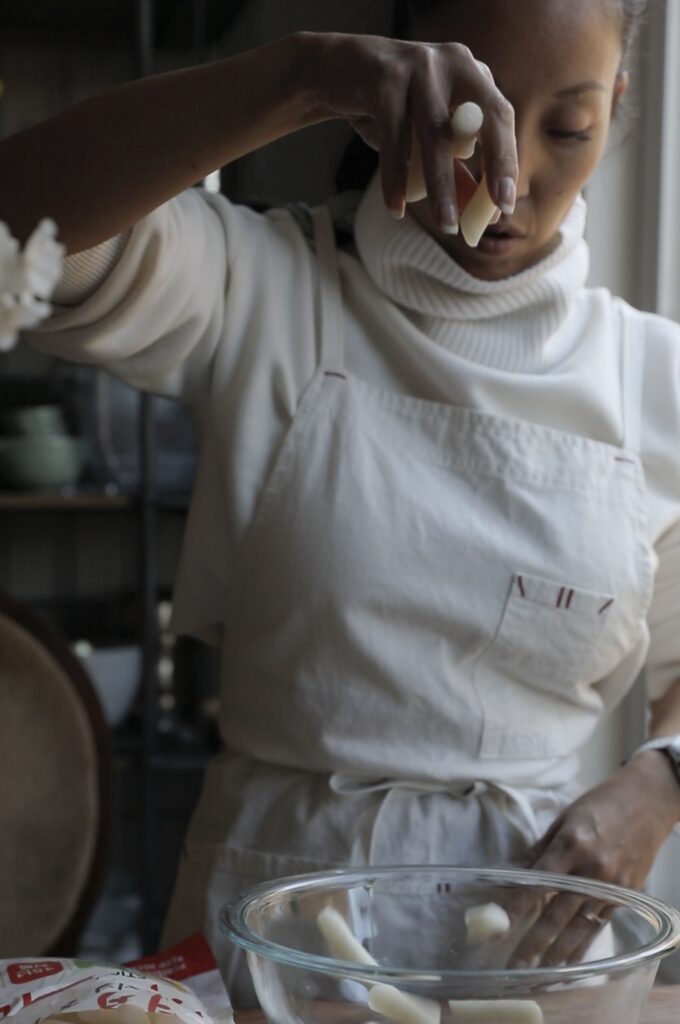















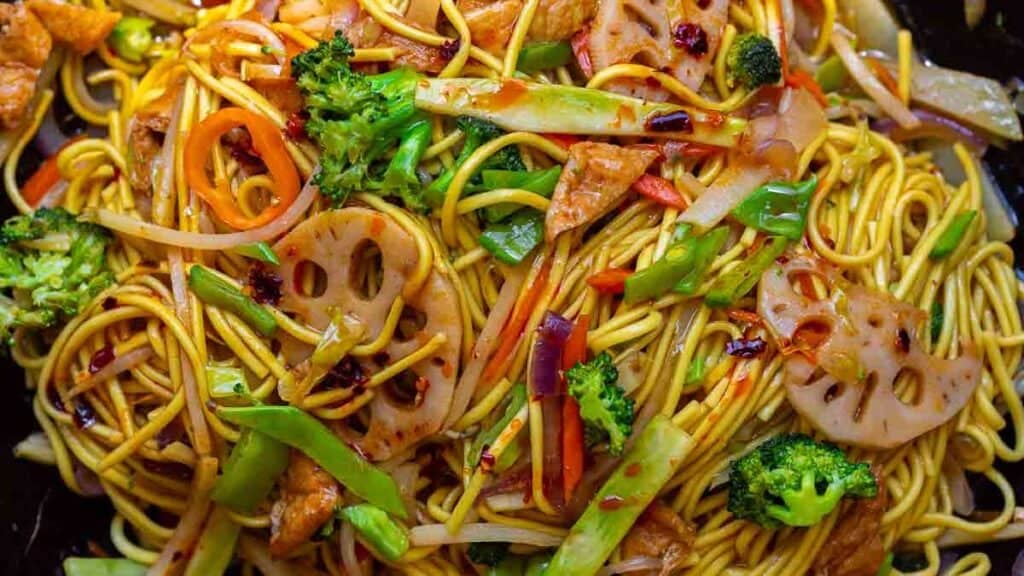
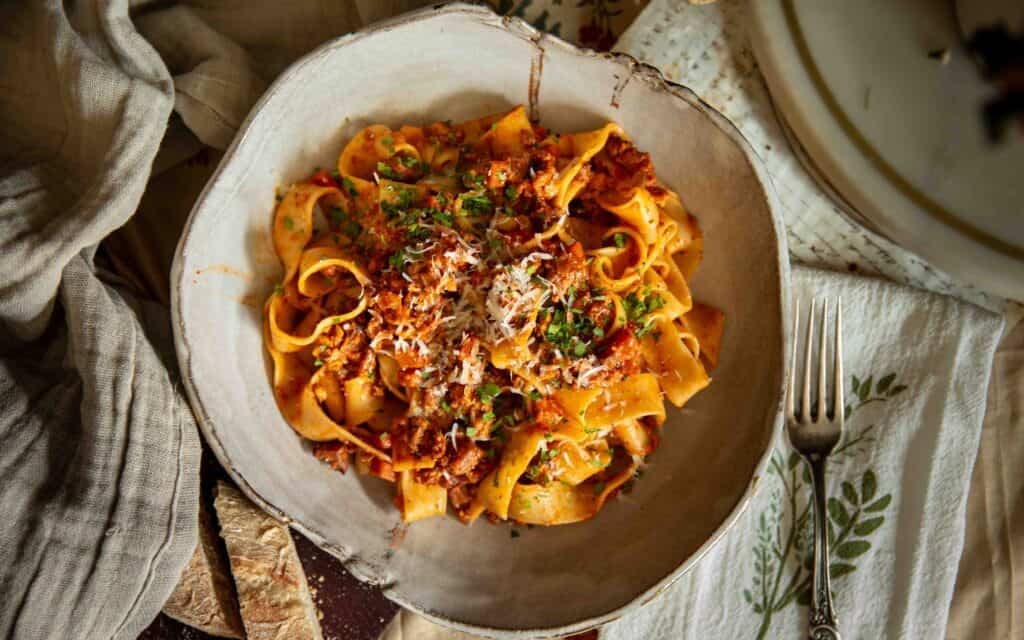
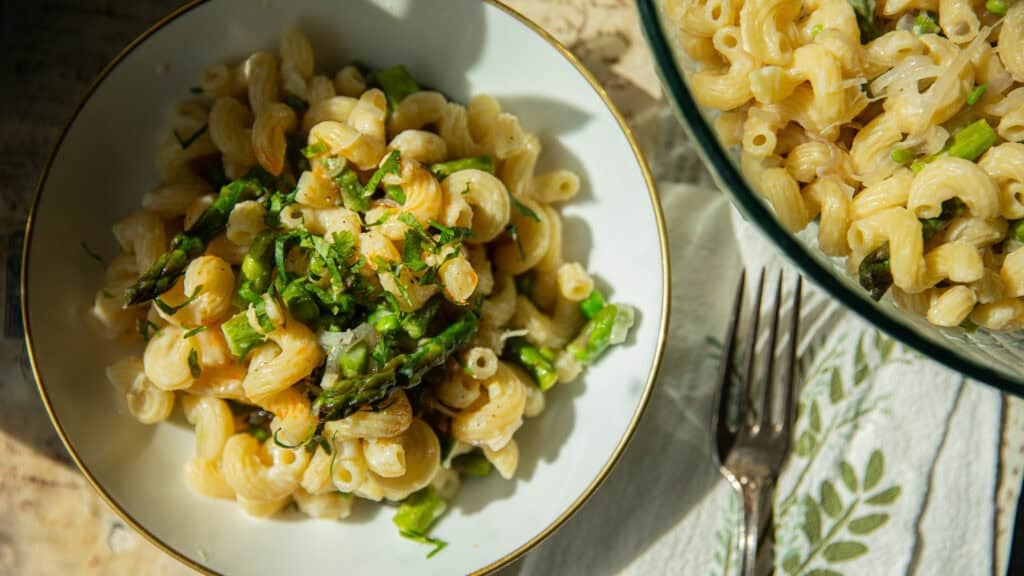







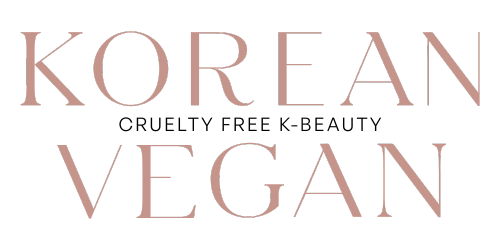

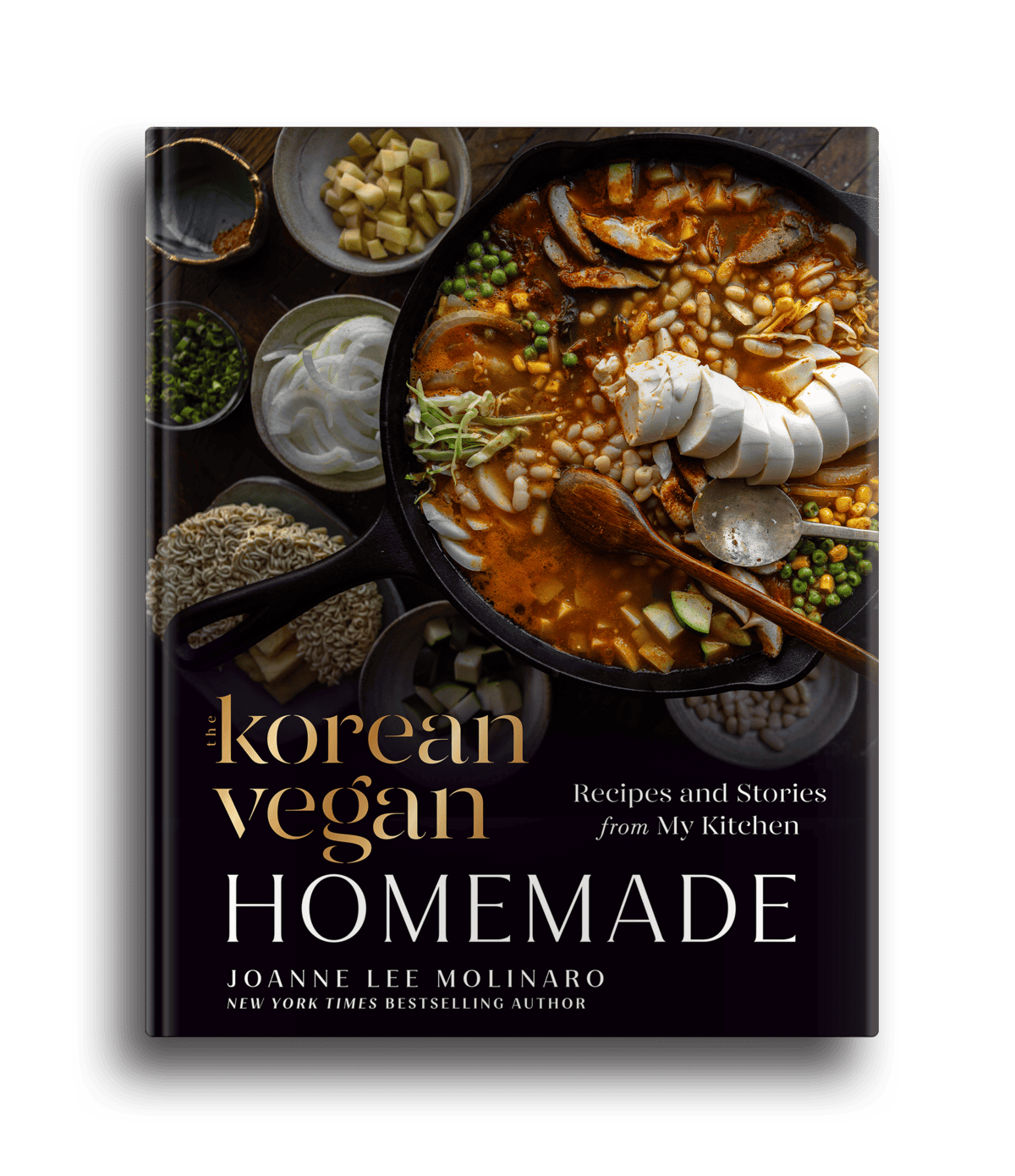
For those who are looking for a gluten free, vegan chunjang, Jinmi makes a rice chunjang – I recently picked some up and plan to use it this week.
Greetings and thank you for your time. Do you happen to know how long roasted chunjang lasts in the fridge once opened?
I have a jar if the Wang brand from your picture and was curious if it was still good.
Many, many thanks for you time and help.p
Hi Elizabeth! Should be good for up to 3 months in the fridge! 🙂
Wonderful! Thank you so much; you are beyond appreciated.
Take care and stay awesome!
This dish has been on my “to someday make” list for years. I love Korean food, and I am so happy I found you and your veganized recipes! I am very lucky to have a big Asian grocery near me called ADong. I use the Twin Marquis fresh noodles they carry. They offer many different types and shapes. I find them to be really good, but don’t have anything to compare them to. This dish is SO GOOD! The flavor is so deep and rich. Luxurious. I used shiitakes (no vegan meat) and corn starch because that’s what I had on hand. I was stunned by the deliciousness, given the ease of the recipe. Thank you so much!
I love black bean dishes- can you publish one with lots of black beans?
You got it Karen!!
Sorry where when how much BLACK BEANS to add?
Hi Karen. I suggest you read through the post! The “black beans” are part of the chunjang or paste that makes the sauce and they are fermented soybeans–not the black beans I think you’re probably thinking of. Thanks!
We love the recipe in your cookbook and have made it many times. This version with Impossible Steak Bites will be on my list to try when I can find them. Love your cookbook and am excited for the new one.